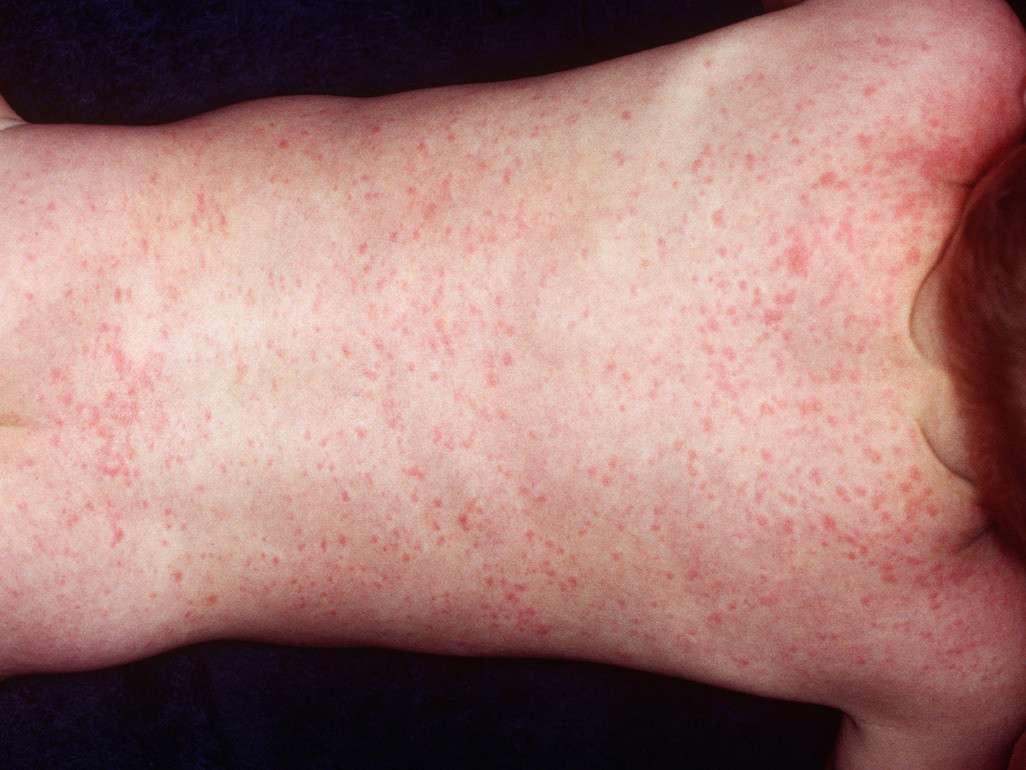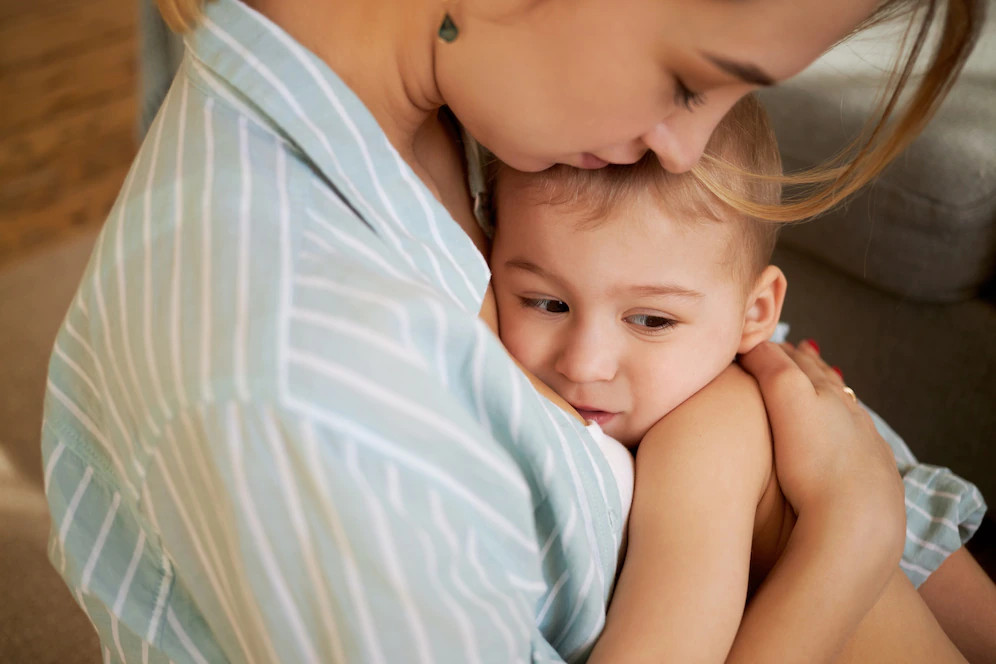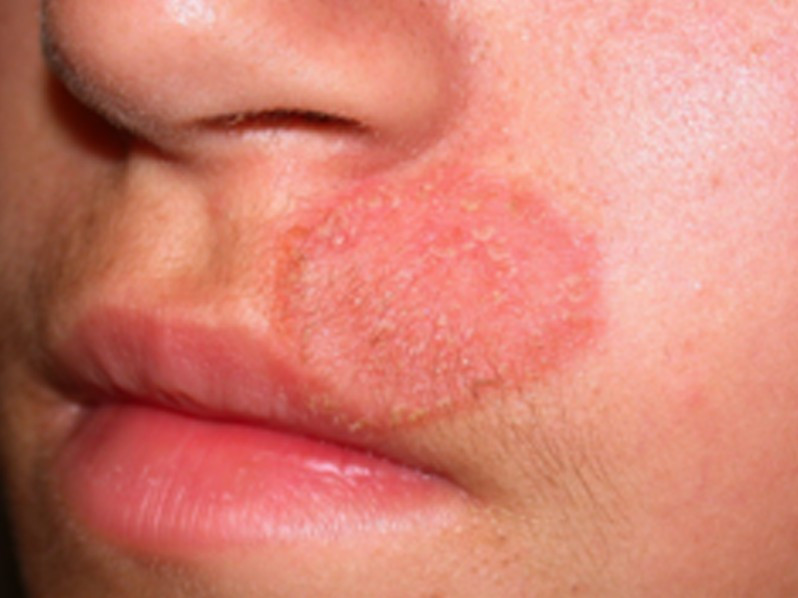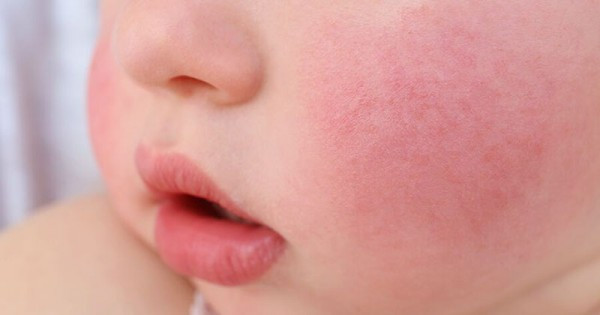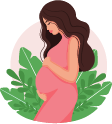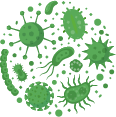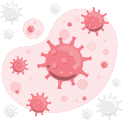Definisi
Roseola infantum adalah penyakit infeksi ringan yang ditemukan secara global dan sering terjadi pada bayi dan anak kecil. Sebelumnya, roseola infantum disebut dengan campak bayi. Roseola infantum sering menjangkiti anak-anak usia 6 bulan sampai 3 tahun. Kondisi ini merupakan penyebab dari 10-45% demam pada bayi. Sekitar 95% anak-anak yang telah berusia 2 tahun pernah mengalami infeksi roseola infantum.
Nama lain roseola infantum adalah penyakit keenam (sixth disease), eksantema subitum.
Penyebab
Roseola infantum disebabkan oleh infeksi virus dari kelompok virus herpes, yaitu human herpesvirus (HHV) tipe 6 varian B, dan pada frekuensi yang lebih jarang oleh HHV tipe 7. Virus ini adalah virus DNA. Meskipun namanya herpesvirus, namun virus penyebab roseola infantum ini tidak menyebabkan penyakit herpes lainnya seperti herpes mulut.
Roseola merupakan penyakit menular, yang berarti dapat disebarkan dari satu orang ke orang lainnya. Virus HHV-6 sendiri bereplikasi terutama pada kelenjar air liur sehingga akan terdapat pada air liur. Penularan terjadi melalui droplet atau cairan dari saluran nafas yang keluar ketika anak yang terinfeksi berbicara, batuk, atau bersin, lalu terhirup oleh anak lain di dekatnya. Anak dengan roseola infantum hanya dapat menyebarkan infeksi sebelum gejala muncul, sehingga sulit untuk mencegah penularannya ke orang lain. Setelah suhu tubuh anak kembali normal selama 24 jam, anak sudah tidak menularkan virus lagi (meskipun ruam masih ada).
Faktor Risiko
Semua orang dapat terkena roseola infantum, namun virus ini paling sering menginfeksi anak-anak berusia 6 bulan sampai 3 tahun. Sekitar 90% dari seluruh kasus roseola infantum terjadi pada anak-anak berusia di bawah dua tahun. Sebuah studi mengatakan bahwa roseola infantum lebih sering ditemukan pada anak perempuan dibandingkan dengan laki-laki.
Orang dewasa biasanya sudah kebal terhadap penyakit ini karena sudah pernah terinfeksi saat masa kanak-kanak. Setelah seseorang terkena roseola, sistem imun akan membentuk perlindungan terhadap virus tersebut. Hal inilah yang menjelaskan mengapa kebanyakan orang tidak akan terinfeksi dua kali.
Gejala
Kebanyakan gejala roseola sangat ringan sehingga orang tua sering tidak menyadari bahwa anaknya sedang terinfeksi virus. Bahkan, ruam yang ringan juga dapat tidak disadari.
Gejala akan muncul sekitar 10 sampai 15 hari setelah anak terinfeksi. Gejala yang pertama muncul adalah demam tinggi yang mendadak (sering mencapai lebih dari 39.5 celcius). Demam ini biasanya berlangsung dari tiga sampai tujuh hari. Meskipun demam tinggi, anak biasanya tetap aktif dan bangun. Demam biasanya turun secara cepat pada hari ke empat. Ketika suhu tubuh mulai turun atau setelah demam hilang, biasanya akan timbul ruam yang kemerahan. Ruam ini tidak gatal ataupun nyeri. Biasanya ruam timbul pada badan, terutama perut dan dada, dan dapat menyebar ke punggung, leher, lengan dan tungkai, jarang pada wajah. Jika ditekan, ruam akan menjadi pucat atau memutih. Ruam dapat memudar setelah beberapa jam, namun umumnya akan terlihat sampai satu atau dua hari. Beberapa anak hanya mengalami demam tinggi tanpa adanya ruam.
Selain demam dan ruam, anak dengan roseola juga dapat mengalami gejala-gejala mirip flu seperti:
- Hidung berair
- Batuk ringan
- Nyeri tenggorokan
- Pembesaran kelenjar getah bening leher, belakang telinga, atau belakang kepala
- Sakit perut atau diare
- Kejang. Meskipun jarang, suhu tubuh yang meningkat tajam secara mendadak disertai dengan kemampuan virus untuk menembus selaput yang membatasi darah dengan otak, maka infeksi ini dapat menyebabkan kejang demam (kejang yang disebabkan oleh peningkatan suhu tubuh dengan cepat). Meskipun hal ini membuat khawatir, namun biasanya tidak serius.
Diagnosa
Dokter dapat mendiagnosa roseola infantum berdasarkan gejala yang ada pada anak. Adanya roseola infantum akan dipikirkan pada anak berusia 6 bulan sampai 3 tahun yang mengalami gejala khas roseola infantum, yaitu adanya ruam yang timbul setelah demam turun. Pemeriksaan tambahan jarang diperlukan, kecuali untuk menyingkirkan kemungkinan penyakit lain atau untuk mengonfirmasi diagnosa. Jika diperlukan, pemeriksaan yang dapat dilakukan adalah pemeriksaan darah rutin, pemeriksaan biakan virus (kultur) atau tes darah untuk memeriksa antibodi terhadap virus HHV. Pemeriksaan molekul, misalnya polymerase chain reaction (PCR) kuantitatif juga dapat digunakan namun jarang diperlukan.
Tata Laksana
Roseola biasanya berlangsung sekitar empat hari sampai satu minggu dan hampir tidak pernah membutuhkan terapi oleh tenaga medis, melainkan hanya memerlukan terapi untuk mengatasi gejala. Perawatan yang dapat dilakukan di rumah adalah:
- Berikan paracetamol, asetaminofen atau ibuprofen jika anak demam dan terlihat rewel atau tidak nyaman.
- Berikan banyak cairan untuk anak, bisa dengan air mineral, ASI, atau susu formula. Saat demam, terjadi peningkatan kebutuhan cairan pada anak, sehingga kebutuhan cairannya tetap harus terpenuhi
- Antibiotik tidak perlu diberikan karena antibiotik digunakan untuk menangani infeksi bakteri, sedangkan roseola infantum disebabkan oleh infeksi virus
- Ruam tidak perlu diberikan apapun karena tidak menyebabkan gatal ataupun nyeri
Pada penyakit yang berat atau pada anak yang memiliki penurunan sistem kekebalan tubuh akibat kanker, penyakit autoimun, atau kondisi lainnya, maka mungkin dibutuhkan obat antivirus seperti foskarnet atau gansiklovir.
Komplikasi
Kebanyakan anak pulih dari roseola tanpa masalah kesehatan yang berarti. Anak dengan kelemahan sistem imun berisiko untuk mengalami komplikasi seperti:
- Pneumonia
- Infeksi otak
- Peradangan otot jantung (miokarditis)
- Penurunan sel keping darah
- Peradangan hati
- Sindrom Guillain-Barre
- Rhabdomiolisis (kerusakan jaringan otot rangka)
Sekitar 10 sampai 15% dari anak dengan roseola mengalami kejang demam akibat demam tinggi. Kejang demam umumnya berlangsung kurang dari 15 menit. Namun, kejang ini bukan merupakan tanda epilepsi (ayan).
Pencegahan
Tidak ada cara yang diketahui dapat mencegah penyebaran roseola karena penyebarannya terjadi sebelum gejala muncul. Tidak ada vaksin untuk roseola. Cara terbaik untuk menurunkan penyebaran virusnya adalah dengan melakukan kebiasaan hidup bersih dan sehat. Anda dapat menurunkan risiko infeksi dengan:
- Mengindari kontak erat dengan orang yang terinfeksi
- Menutup hidung dan mulut saat batuk atau bersin dengan bagian dalam dari lengan atas atau siku
- Sering mencuci tangan menggunakan sabun dan air mengalir atau hand sanitizer
Kapan Harus ke Dokter?
Anda harus pergi ke dokter jika anak Anda:
- Kurang merespons (sangat mengantuk, sulit dibangunkan)
- Buang air kecil dengan frekuensi yang kurang dari biasanya
- Mengalami demam yang tidak membaik setelah 48 jam
- Mengalami kejang yang berlangsung selama kurang dari lima menit
- Mengalami demam 38.9 derajat atau lebih yang berlangsung lebih dari 24 jam tanpa gejala lainnya
- Memiliki ruam yang gatal atau nyeri
- Mual, muntah, atau diare
- Menunjukan tanda dehidrasi seperti air seni yang berwarna gelap dan lemas
Anda harus mencari pertolongan emergensi jika:
- Anak mengalami kejang yang sudah berlangsung lebih dari lima menit
- Anak tidak sadarkan diri setelah kejang
- Anak kesulitan bernafas (bisa merupakan tanda dari infesi pada paru)
Jika Anak mengalami demam dan ruam kulit yang terlihat seperti bintik merah terang atau ungu yang tidak memucat dengan penekanan, maka ini bisa jadi merupakan tanda dari infeksi meningokokus.
Mau tahu informasi seputar penyakit lainnya? Cek di sini, ya!
- dr Nadia Opmalina
Melbourne, T. (2022). Kids Health Information : Roseola infantum. Rch.org.au. Retrieved 10 May 2022, from https://www.rch.org.au/kidsinfo/fact_sheets/Roseola_infantum/.
Roseola (Sixth Disease): Symptoms, Causes, Treatment & Prevention. Cleveland Clinic. (2022). Retrieved 10 May 2022, from https://my.clevelandclinic.org/health/diseases/15785-roseola-infantumsixth-disease.
Roseola Infantum - Pediatrics - MSD Manual Professional Edition. MSD Manual Professional Edition. (2022). Retrieved 10 May 2022, from https://www.msdmanuals.com/professional/pediatrics/miscellaneous-viral-infections-in-infants-and-children/roseola-infantum.
Mullins, T., & Krishnamurthy, K. (2022). Roseola Infantum. Ncbi.nlm.nih.gov. Retrieved 10 May 2022, from https://www.ncbi.nlm.nih.gov/books/NBK448190/.


